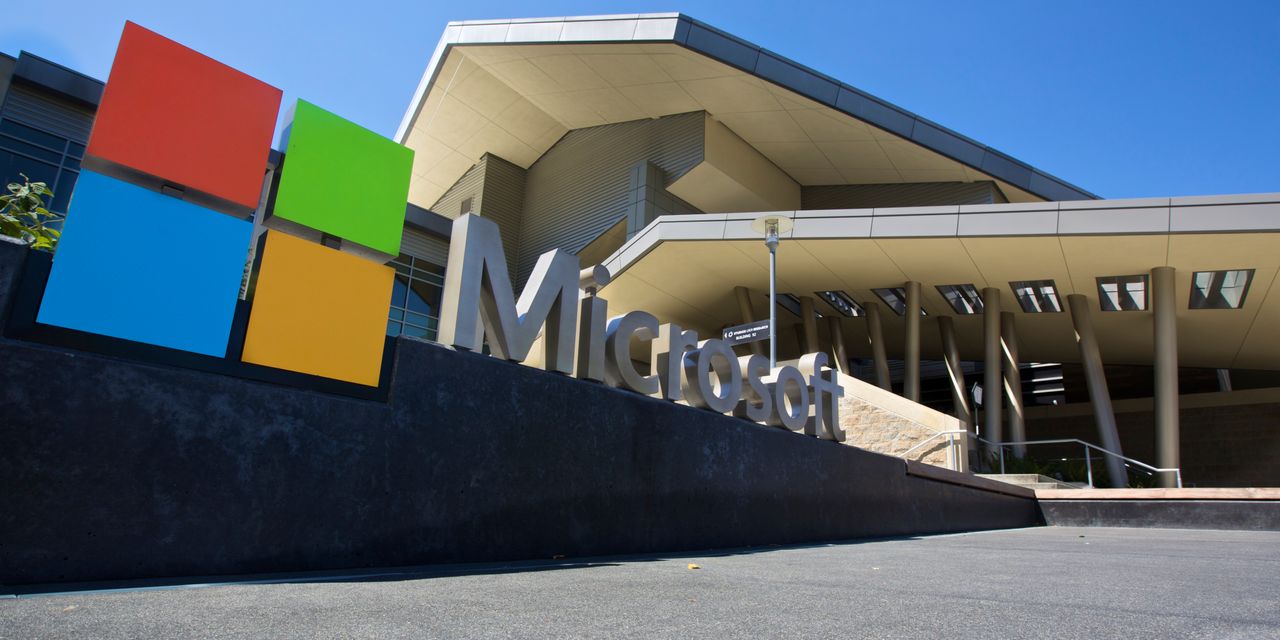Microsoft Corp. shares slipped in after-hours trading Tuesday despite an earnings beat, as the company’s cloud-computing revenue came in lower than expected and its core cloud product, Azure, grew at a slower rate than projections amid concerns about the economy.
Microsoft
MSFT,
reported fiscal first-quarter earnings of $17.56 billion, or $2.35 a share, down from $2.71 a share in the same quarter a year ago, when Microsoft disclosed a 44 cent-per-share tax benefit. Revenue increased to $50.1 billion from $45.32 billion a year ago. Analysts on average were expecting earnings of $2.31 a share on sales of $49.66 billion, according to FactSet.
Microsoft shares fell between 1% and 2% in after-hours trading following the release of the results, after closing with a 1.4% increase at $250.66. Microsoft stock tends to react most strongly in after-hours trading following earnings reports after executives share their forecast for the current quarter in their conference call, which is scheduled to begin at 5:30 p.m. Eastern.
Microsoft has started to show some effects of a weakening macroeconomic climate, confirming layoffs of fewer than 1,000 employees earlier this month. Microsoft has suffered from the strengthening dollar, as well as a sharp downturn in personal-computer sales, which spiked during the pandemic but are now showing record regression.
For more: The pandemic PC boom is over, but its legacy will live on
Microsoft reported PC revenue of $13.3 billion for the quarter, roughly flat from $13.31 billion a year before and beating the average analyst estimate of $13.12 billion, according to FactSet. While PCs have long been what consumers largely know Microsoft for, their importance to the company’s financials has declined in recent years.
“Historically, Windows was a very large driver of Microsoft revenue and, given its strong margins, a disproportionate driver of earnings,” Bernstein analysts wrote in a preview of the report, while maintaining an “overweight” rating. “Over time other businesses, especially Microsoft’s commercial Cloud, have grown fast while the Windows business has grown quite slower, decreasing the relative impact of Windows.”
Microsoft’s cloud-computing business has grown into the most important and largest business for the company, with the “Intelligent Cloud” segment reporting first-quarter revenue Tuesday of $20.3 billion, up from $16.96 billion a year ago but slightly lower than the average analyst estimate tracked by FactSet of $20.46 billion.
Microsoft said that Azure grew by 35%, while analysts on average were expecting 36.5% growth, according to FactSet. That is a marked slowdown from Azure’s 40% growth rate in the previous quarter, as well as the 50% growth shown in the same quarter last year. Microsoft only reports percentage growth for its core cloud-computing product, even as main rivals Amazon.com Inc.
AMZN,
and Alphabet Inc.
GOOGL,
GOOG,
report revenue and profit margin for their cloud-computing products.
Opinion: The cloud boom is coming back to Earth, and that could be scary for tech stocks
“This quarter Microsoft Cloud revenue was $25.7 billion, up 24% (up 31% in constant currency) year-over-year. We continue to see healthy demand across our commercial businesses including another quarter of solid bookings as we deliver compelling value for customers,” Chief Financial Officer Amy Hood said in a statement.
Microsoft’s other revenue segment, “Productivity and Business Processes,” reported revenue of $16.5 billion, up from $15.04 billion a year ago and higher than the average analyst estimate of $16.13 billion, according to FactSet. That segment includes Microsoft’s core cloud-software properties such as its Office suite of products — which is being officially renamed Microsoft 365 — as well as LinkedIn and some other properties.
Microsoft’s second-quarter guidance will be crucial to investors hoping that the tech giant can withstand any economic jolts headed its way, and perhaps take advantage of weakness from smaller software rivals. Analysts on average were expecting second-quarter revenue of $56.16 billion heading into the print, according to FactSet, and some wrote that they would like to hear more from Microsoft executives about the picture for the full year.
“Our hope is that management provides a bit more color on full-year fiscal 2023 beyond just the double-digit revenue growth and operating margins being roughly flat commentary from last quarter,” MoffetNathanson analysts, who have a “market perform” rating and $282 price target on the stock, wrote in their preview. “We would expect headcount-related revenue streams like Office to see increasing headwinds in coming quarters, but volume businesses like Azure, which is tied to data, being more resilient.”
Microsoft stock has declined 25.5% so far this year, as the S&P 500 index
SPX,
has dropped 20.3% and the Dow Jones Industrial Average
DJIA,
— which counts Microsoft as one of its 30 components — has declined 13.3%.
